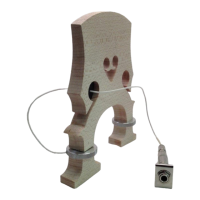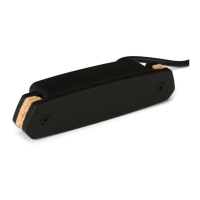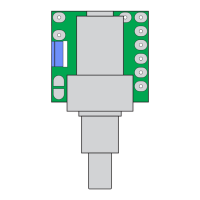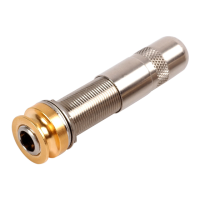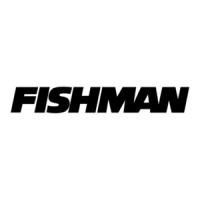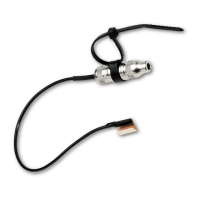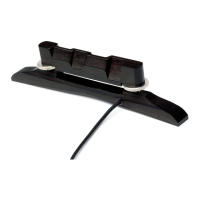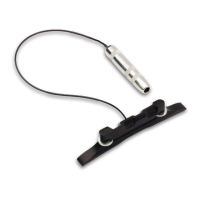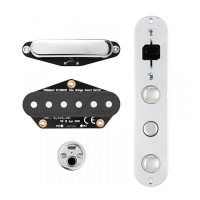INSTALLATION
1. Measure the opening of the bass side wing slot on the bridge with a vernier
caliper. The opening should be between .060-.090" (1.5-2.3mm) for proper fit.
If the wing slot opening of the cello measures more than .090" (2.3mm), the leg
facing the pickup must be shimmed. For that purpose, we have provided a strip
of wooden shim material that can be easily cut with scissors, stacked and glued
to produce a shim of any required thickness.
2. Slide the transducer into
the bass wing slot as
shown. Make certain that
the sensing element is in
contact with the wing face
and that the spring (made
of tempered beryllium cop-
per) is in contact with the
corresponding "leg" face of
the bridge.
NOTE: For best perfor-
mance, the ultimate wing
slot opening should be
.070" (1.8mm).
3. For permanent installation, use any appropriate wood adhesive to bond the shims
to the face of the bass side wing. As a result, the shims will be located between
the transducer’s sensing element and the bass side wing.
NOTE: The performance of the C-100 is affected by the amount of contact area
between its sensing element and the wing face of the bridge. Accordingly, the per-
formance may be adversely affected if the wing face has been stylized or carved
in any way.
4. Once the transducer is properly inserted into
the bridge, the next step is to mount the adhe-
sive-backed jack mount to the back side of the
tailpiece. First, peel off the release film from
the holder and then press the holder firmly in
place below the fine tuning machines of the
tailpiece. Position the holder so that the jack,
when slipped into the holder, will be at a right
angle (90 degrees) to the tailpiece.
5. Insert the jack into the holder and snap
shut. Since the wire is somewhat micro-
phonic, it should not be allowed to lie on
the face of the instrument.
FINE TUNING
Once the C-100 is properly mounted, plug the instrument into an amplifier and play
at a low volume. Carefully shift the position of the C-100 within the slot and listen for
the best location.
NOTE: If installation is to be permanent, a small drop of cyanoacrylate adhesive on
the spring side (lower face) of the transducer can be used.
PLUGGING IN
Due to the nature of passive pickups, the type of cable you use and the input you plug into will affect
the quality of your sound.
INSTRUMENT CABLE
Cable lengths over 10 feet (before preamp) will cause audible high frequency loss. Use a high qual-
ity, low capacitance shielded cable. This will insure minimal tone coloration and hum. Using fully
shielded metal plugs will also help eliminate hum.
KINDS OF AUDIO INPUTS
Because of the lack of standardization for high impedance audio inputs, special attention should be
paid to what you are plugging into:
3
3
C-100 Cello Pic
C-100 Cello Pic
kup
kup
4
4
C-100 Cello Pic
C-100 Cello Pic
kup
kup
The C-100 will sound best when plugged directly into an input with a 10 Meg Ohm impedance.
At 10 Meg Ohm , the full frequency response of the instrument is reproduced. The C-100 can
also be plugged into inputs as low as 1 Meg Ohm with adequate results. At 1 Meg Ohm
,
the
bass frequencies will be slightly rolled off.
Preamps
We strongly recommend using a 10 MOhm, impedance matching, buffered preamp in conjunction
with the pickup.
A matching preamp will:
1. Realize the full frequency response potential of the pickup.
2. Permit long cable runs (after the preamp) without signal deterioration.
3. Allow precise volume and tone shaping with dedicated EQ.
4. Ensure compatibility with virtually any instrument level audio input available.
Fishman Transducers manufactures a complete line of compatible preamps,
all with 10 Meg Ohm inputs:
POWERJACK - Miniature Endpin Preamp
MODEL GII & BII - Outboard Acoustic Instrument Preamp
AGP-2 - Onboard Instrument Preamp
PRO-EQ II - 4 Band Acoustic Instrument Preamp
PRO-EQ PLATINUM - Outboard Acoustic Instrument Preamp / EQ / D.I.
DUAL PARAMETRIC D.I. - Fully Parametric Two Band Preamp / D.I.
ACOUSTIC / BASS BLENDER - 2 Channel Pickup / Mic Preamp
POCKET BLENDER - 2 Channel Pickup/Mic Preamp
MUSICAL INSTRUMENT AMPLIFIERS
Most musical instrument amplifiers (at least 1 Meg Ohm input impedance) will yield useable
results. Acoustic instrument amplifiers (such as the Fishman Acoustic Performer Pro) have a 10
Meg Ohm Piezo input; ideally matching the pickup.
DIRECT BOXES
You can plug the C-100 into an "active" direct box (1-10 Meg Ohm input) with very good results.
Using a passive direct box will sound weak and thin.
P A / RECORDING CONSOLES
Professional PA and recording consoles have a much lower input impedance than what is accept-
able for the C-100; you will need an impedance matching preamp. Plugging a passive piezo
pickup into a mixer without an impedance matching preamp will sound harsh and thin.
5
5
C-100 Cello Pic
C-100 Cello Pic
kup
kup
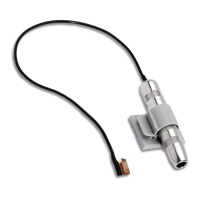
